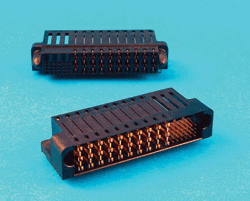Connector manufacturers adjust to demands for increased current density and smaller packaging
BY JOHN DODDS
FCI
Etters, PA
http://www.fci.com/powersolutions
Leading power connector manufacturers today are focused on maximizing linear current density—that is, offering higher per-contact current ratings while consuming less space along the PCB edge. Greater density is not limited to power connector products and reflects an overall trend in the connector industry toward channeling more power and signals into less space.

Power connectors must offer greater densities than ever before while handling increased current and voltage.
Market and industry needs
Similar to other component innovations markets within the component industry, advances in power connectors are primarily being driven by requirements within the telecom and datacom markets. However, the needs of industrial, instrumentation and even the medical markets are also considerations.
These advances come in the form of higher power in smaller footprints with advanced functionality. Current density, product profile heights, and airflow above, below, and through the connector are now key considerations for power connector manufacturers.
While processors are now more efficient and consume less power than ever, overall systems have more processors, which leads to an overall increase in power consumption. Also, increased rack density and/or higher wattage power supplies require higher power density connector solutions.
In the power supply interface market, one way to increase option for increasing power density is to create new products that build on the industry-accepted practice of using stamped-and-formed power contacts. These products use the latest in high-conductivity copper alloys, optimized contact designs, and ventilated housings to meet and exceed demanding power applications.
One connector system recently introduced suits high-wattage power supplies used in servers, storage enclosures, communications equipment, and hot-swap redundant N+1 power distribution systems. This next-generation product provides capability for both power and signal contacts in a single connector to meet the power-distribution and power-control aspects of all power-supply interface applications. The highly configurable connector is capable of dc power, ac power, and signal contacts in a single molded housing.
Thermal management
It’s no surprise that another major trend for power connectors is a move toward more compact, lower-profile packages. As the number of processors, memory, and ICs in a system continues to increase, more heat is generated, making thermal management even more important.
Some applications require a low-profile height and reduced width to minimize obstruction and enhance airflow. This also frees up space to allow placement of more components.
The transition from the rack-mount-server form factor to the denser blade form factor in the data center is one example of an industry trend driving the need for more compact connector solutions to accompany greater power (and signal) density.
Host-to-card applications
In host-to-card applications (in a midplane-to-blade interface, for example), one option for increasing power density is including power delivery capabilities in signal connectors (particularly in connectors designed for high-speed applications). For example, one high-speed connector product makes use of shieldless technology to increase signal density.
A natural outgrowth of that technology was a combined high-speed signal/power connector designed for both backplane and orthogonal midplane applications that allows signal and power insert-molded-leadframe-assemblies to be mixed. This combined high-speed signal/power connector design offers flexible pin configurations with the greatest signal and power density in all three dimensions.
This flexibility helps address the mechanical and thermal concerns of system designers by offering standard orthogonal and/or backplane signal/power connectors with high-current power capabilities. These connectors can be configured in many ways to satisfy unique application requirements without the need for new tooling or long lead times.
Stackability
Another trend in power connectors is a move toward stackability. Power connectors are being designed to stack beside other host-to-card connectors, allowing the flexibility to place high-speed and power modules adjacent to one another.
This modularity allows for plug-and-play of high-speed, signal, power, and other types of connectors. This minimizes board real estate requirements while optimizing performance.
Cost and sourcing
The electrical performance and physical characteristics of a connector are not the only issues to consider in transitioning to increased power density. It’s one thing to design a connector that provides a fine pitch, a small footprint, and low-profile height.
However, if this comes at the expense of performance, the needs of more challenging applications cannot be met. The manufacturing process of stamping and forming helps to make these higher densities possible. Stamped-and-formed power contacts are an innovative and very cost-effective alternative to expensive screw-machined contacts for high-current applications.
Most end-customers also demand that products are multisourced. System designers require the best available technology but procurement teams require that products be available from at least two sources.
Multiple sources allow end-customers to avoid continuity of supply issues while, at the same time, to enjoy shorter lead times, competitive pricing, and superior customer support and service. A savvy customer will look for a product that is multi-sourced and a dependable connector manufacturer will make such products available. Also, proper agency approvals (such as UL, CSA, TUV, etc.) are needed to ensure that power products meet the required safety regulations.
Finally, with the breadth of product available from any given connector supplier, customers are looking for a manufacturer that makes specifying and purchasing power connectors simple and straightforward. In today’s economy, manufacturers that offer superior technology, service, and support at an affordable price will gain loyal customers and find wider implementation of their products in a variety of applications. ■
For more on power connectors, visit http://www2.electronicproducts.com/Interconnections.aspx.
Advertisement
Learn more about FCI Electronics





